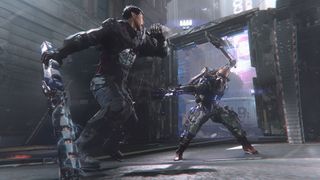Looking at the big picture, The Surge 2 seems very similar to its predecessor and other Soulslike action RPGs. It has the deliberate combat, save points that respawn your enemies, tough boss fights that may or may not push you to pull some hair out. You know, the classics. Somehow, though the sequel finds its way to a more distinctive playstyle through small refinements, some of which go against genre conventions. It’s tough without being obtuse, challenging without forcing you to wrestle for every inch of progress. Though it has some serious flaws that hold it back from greatness, The Surge 2 manages to make more of its premise and find fun playing with the quickly hardened conventions of the Soulslike genre.
From the Factory to The Big City

The Surge 2 recalibrates the narrative of the original, taking its premise – robots and cyborgs gone rogue – and applying it to a larger world. This time, instead of a robot factory, swarms of nanomachines are wreaking havoc in futuristic metropolis Jericho City. As an unnamed, custom character, you wake up in a post-apocalyptic city with no memory, aside from the fact that you were in a plane crash. A trail of breadcrumbs quickly appears, leading you towards finding out more about who you are, where you came from, and what to do next.

Release date: September 24, 2019
Platform(s): Xbox One, PS4, and PC
Developer: Deck13
Publisher: Focus Home Interactive
The mystery, and really the plot around it, feels like background noise. You will likely solve the game’s mysteries long before the answers are made explicit in the story, which makes the quest to uncover the truth drag on. It doesn’t help that the characters you meet along the way lack nuance, a pastiche of Mad Max-style post-apocalyptic clichés, lack the depth necessary to make you care about what’s happening in the world.
Despite this, The Surge develops some interesting texture through its visual design. The Surge 2 takes a large leap forward from the original, both in visual fidelity and the ingenuity of its people, places, and things. The heavy-duty industrial weapons and armor of The Surge have given way to a more fantastical range of weapons, including crudely built axes to sleek, futuristic spears. There is still a common thread in that most of the weapons, armor and post-apocalyptic structures have a jury-rigged look, where even the best weapons look like they’re built from parts originally intended for something else. Likewise, the rubble of Jericho City itself is a perfect pairing for the maze-like design of a Soulslike. Rubble or malfunctioning doors that block your path at one moment can shift or get fixed, opening new shortcuts.
Rip and Tear RPG

Luckily, the only thing you really need to know is that the city is a wasteland and nearly everyone is going to try and kill you, and that you should kill them first. As with the original title, The Surge 2’s forté is its distinctive combat and progression. You have the ability to target sections of the body – legs, arms, head, or torso – and once suitably damaged, you can use a finishing move to rip that section from the body. Successfully extracting a limb earns you either a new weapon or piece of armor for that body part, or crafting materials to improve that type of gear.
The system adds short- and long-term strategy and extra risk to every fight. To upgrade and improve your armor evenly, you want to make sure you target different limbs in every fight. Plus, many enemies have unarmored limbs, which you can target to kill them quickly without earning any loot.

Don’t think too long, though: The Surge 2 rewards extremely aggressive play. Your battery power, which fuels your heal and other injections, charges when you hit an enemy and slowly drains if you go too long without doing so. At the same time, your enemies are more than capable of punishing you for forcing an attack or button-mashing. The systems pair well in that way: a deft player can size up their opponents, figure out what they want to get out of a fight, and how to get it without missing a beat.
Between fights, you’re taking the crafting materials and new gear, both from dismembered enemies and hidden item drops hidden around every corner, and using it to customize your cyborg “rig,” which includes your armor and “implants”, which include abilities and perks. When you earn experience and level up, you gain the ability to upgrade one of three stats – health, stamina, and battery power. You also gain more “core power”, which works like a weight limit to force you into making choices about how to upgrade your rig.

This version of the system feels more streamlined than its predecessor. In the original Surge, all upgrades aside from your health were tied to implants and item-based upgrades. In this version, there’s more universal progress and the customization is limited to honing your playstyle. Figuring out how to upgrade efficiently and effectively seems much easier, and you are much less likely to feel “stuck” in a build because you’re waiting for an upgrade that fits into your system.
As a result, it’s easier to move forward without constant tinkering and inventory management. There will come a time when you face an opponent or group — sometimes it’s a boss, others it’s just a tough scenario — and you’ll need to reassess your character’s setup, but you don’t get a constant nagging feeling that you could or should optimize constantly.

These tweaks to the system, all combined, give The Surge 2 a propulsive pace. Forward progress feels very attainable, relative to other Soulslikes. Since healing is tied to your battery, rather than a limited number of charges to be refilled at a save point, you are less prone to replaying stretches of each world many times to memorize attack patterns and build your way up to opening a new shortcut and making concrete progress.
To players who already “got good” trolling the mean streets of worlds like Lordran and Yarnham, that might sound like The Surge 2 has gone soft. But I wouldn’t go quite that far. Every fight requires careful game-time strategy we’ve come to learn from The Surge and games like it -- even simple enemies will kill you if you aren’t paying attention. Likewise, each boss demands you memorize patterns and adapt to them precisely. Things just move quickly and there’s room for you to build momentum. When you succeed you feel the progress more. When you die, you feel the sting less.
Reviewed on PC.

